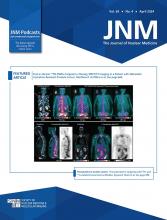With the approval of 18F-rh-PSMA-7.3 (18F-flotufolastat [Posluma; BlueEarth]), the appropriate use criteria for prostate-specific membrane antigen (PSMA) PET needs to be updated a second time (1,2). The approval for 18F-rh-PSMA-7.3 was based on 2 prospective phase 3 clinical trials, the LIGHTHOUSE and SPOTLIGHT trials (3,4). The LIGHTHOUSE trial evaluated the sensitivity and specificity of 18F-rh-PSMA-7.3 in men with unfavorable intermediate- to very high–risk prostate cancer and demonstrated a sensitivity ranging between 23% and 30% across the 3 readers and a specificity of 93%–97% (4). The sensitivity was slightly lower than that reported with 18F-DCFPyL and 68Ga-PSMA-11 (5,6), which might be explained by the higher percentage of men with unfavorable intermediate-risk prostate cancer in the LIGHTHOUSE trial. The SPOTLIGHT trial evaluated the verified detection rate (ranged from 51% to 54% across readers) and positive predictive value (ranged from 46% to 60%) in patients with biochemically recurrent prostate cancer (3). Given the differences in methodology, it is difficult to compare these rates with the comparable trials performed with 18F-DCFPyL and 68Ga-PSMA-11, in which correct localization rate and positive predictive value were used, respectively (7,8). Overall, all 3 agents should be considered equivalent for the staging of disease initially and at the time of biochemical recurrence.
The third main indication for PSMA PET is the selection of patients for PSMA radioligand therapy. In the most recent update to the PSMA appropriate use criteria document, 18F-DCFPyL and 68Ga-PSMA-11 were considered equivalent for the selection of patients with PSMA radioligand therapy (2). There are no data evaluating the role of 18F-rh-PSMA-7.3 for selecting patients for PSMA radioligand therapy, although admittedly the same is true for 18F-DCFPyL. The appropriate use committee agreed that 18F-rh-PSMA-7.3 can also be used to select patients for PSMA radioligand therapy. Because of the higher physiologic uptake in the liver, patients who meet the VISION criteria using rh-PSMA-7.3 are candidates for treatment. Currently, there are limited data on the biodistribution of 18F-rh-PSMA-7.3 and how that compares with 18F-DCFPyL and 68Ga-PSMA-11, and therefore it is unclear what the lower limit of uptake with 18F-rh-PSMA-7.3 should be for patient selection, and it is possible that there are a small minority of patients who would meet criteria for treatment with 68Ga-PSMA-11 and 18F-DCFPyL but would not meet criteria for 18F-rh-PSMA-7.3.
The approval of 18F-rh-PSMA-7.3 provides another PSMA-targeted radiopharmaceutical that will help increase patient access to PSMA PET imaging. Overall, 18F-rh-PSMA-7.3 should be considered equivalent to 68Ga-PSMA-11 and 18F-DCFPyL, with the caveat that the higher uptake in the liver with 18F-rh-PSMA-7.3 may impact the selection of a small number of patients for PSMA radioligand therapy compared with patients screened using the other 2 agents.
DISCLOSURE
Thomas Hope has grant funding to the institution from Clovis Oncology, GE Healthcare, Lantheus, Janssen, Novartis, the Prostate Cancer Foundation, Telix Pharmaceuticals, and the National Cancer Institute (R01CA235741 and R01CA212148). He received personal fees from Bayer, Cardinal Health, BlueEarth Diagnostics, and Lantheus and received fees from and has an equity interest in RayzeBio and Curium. No other potential conflict of interest relevant to this article was reported.
Footnotes
Published online Jan. 4, 2024.
- © 2024 by the Society of Nuclear Medicine and Molecular Imaging.
REFERENCES
- Received for publication November 9, 2023.
- Revision received November 9, 2023.







